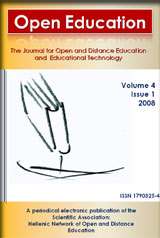Blended Collaborative Learning for Action Research Training
Abstract
This action research study investigated the application and use of a blended collaborative learning model as a vehicle for developing in-service teachers’ action research skills in a field-based Master’s program. It also explored the roles of the instructor through the lens of the ‘four hats’ metaphor (Bonk et al., 2001). Research results endorsed the tremendous potential of both the collaborative and blended aspects of the selected instructional approach towards the creation of an interactive community of learners, as well as the development of deeply reflective thinking skills. From the course design perspective, this instructional approach facilitated the transformation of an action research training course to what Laurillard (2002) calls the “reflective practicum”. For this transition to occur, three highly significant conditions need be in place and work in parallel, namely the students’ own motivation and drive to achieve professional growth as opposed to those students that just wanted to complete the degree; as well as a positive student-instructor relationship, and the instructor’s continuous support, input and guidance.
Key words: Blended Learning, Action Research, CMC, Collaborative Learning, Higher Education
Article Details
- How to Cite
-
Avgerinou, M. D. (2008). Blended Collaborative Learning for Action Research Training. Open Education: The Journal for Open and Distance Education and Educational Technology, 4(1), 17–36. https://doi.org/10.12681/jode.9727
- Issue
- Vol. 4 No. 1 (2008)
- Section
- Section 1
Copyright Notice
Authors who publish with this journal agree to the following terms:
Authors retain copyright and grant the journal right of first publication with the work simultaneously licensed under a Creative Commons Attribution Non-Commercial License that allows others to share the work with an acknowledgement of the work's authorship and initial publication in this journal.
Authors are able to enter into separate, additional contractual arrangements for the non-exclusive distribution of the journal's published version of the work (e.g. post it to an institutional repository or publish it in a book), with an acknowledgement of its initial publication in this journal.
Authors are permitted and encouraged to post their work online (preferably in institutional repositories or on their website) prior to and during the submission process, as it can lead to productive exchanges, as well as earlier and greater citation of published work.



